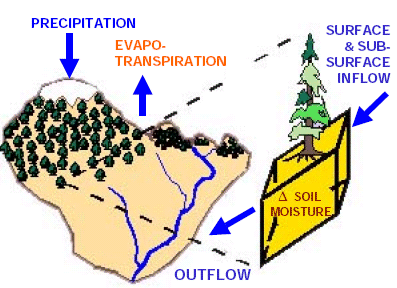Tree rings and streamflow
One might think that trees growing right along a river would act as natural stream gages, providing the best information about streamflow. But in fact the growth of these riparian trees is usually insensitive to variation in streamflow, since soil there is usually saturated, even during drought.
The trees that do provide good proxy streamflow data are typically found on slopes well above the river channel. The relationship between streamflow and the growth of these trees is indirect yet strong. The same climate factors, primarily precipitation and evapotranspiration (loss of moisture from plants and soils), control both the growth of moisture-limited trees and the amount of water that reaches the stream (see figure, below left). One can think of the tree as a "dipstick" recording the overall water balance in a river basin--which is eventually expressed as streamflow.


The trees that provide the very best information about streamflow variability in the Colorado River basin—those particularly sensitive to fluctuations in moisture—are species such as ponderosa pine, pinyon pine, and Douglas-fir, growing on dry and rocky sites where soil moisture storage is minimal (see photo, above right). Trees growing in these sites are also less likely to be subject to non-climate disturbances, such as fires and insect infestation, and the effects of competition from nearby trees. In addition, the oldest individuals of these species tend to be found on these sites.
Trees don't necessarily have to be located within the stream basin in question. Because the atmospheric flows of moisture that affect both tree growth and streamflow do cross drainage divides, sometimes trees located a great distance away can be helpful in reconstructing streamflow at a particular gage.
Generating a streamflow reconstruction
The extension, or reconstruction, of a streamflow record using tree rings begins with the collection and development of tree-ring chronologies. A chronology is a series of annual values derived from the ring-width measurements of 10 or more trees of the same species at a single site. To create a tree-ring chronology, cores from the sampled trees at each site are crossdated (that is, patterns of narrow and wide rings are matched from tree to tree) to account for missing or false rings, so that every annual ring is absolutely dated to the correct year. Then all rings are measured using a computer-assisted measuring device. After growth-related trends (that is, unrelated to climate) are statistically removed, the ring-width values from all sampled trees for each year are averaged to create a time series of annual ring-width indices, called the tree-ring chronology.
Once a gaged flow record (such as the Lees Ferry natural flow record) is selected for reconstruction, a set of tree-ring chronologies from the region around the gage is calibrated with the gage record to form a reconstruction model. A statistical technique called multiple linear regression is commonly used. The reconstruction is evaluated by comparing the observed gage values with the reconstructed values and assessing the amount of variance in the gage record that is explained by the reconstruction. The reconstruction model is then validated by either testing it on a portion of the gage data that was withheld from the calibration process, or testing the ability of the chronologies used in the model to estimate streamflow in different subsets of the data. Once the reconstruction model is validated, the model is applied to the tree-ring data for all available years to generate the full reconstruction.
For a more information on the reconstruction process, see the resources on the Tree-Ring Info page.



